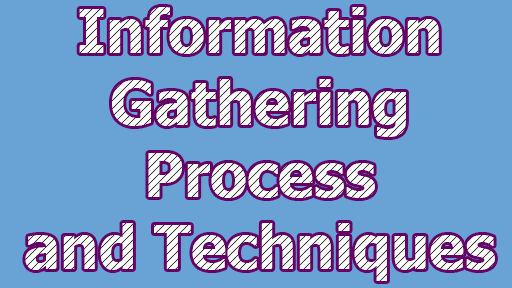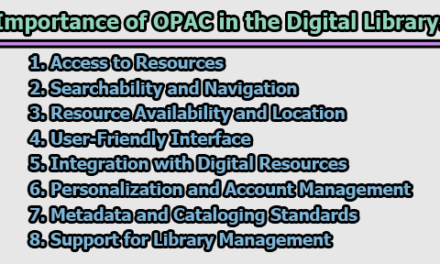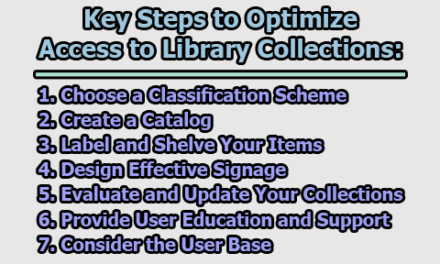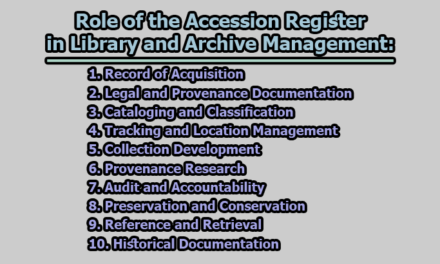Information Gathering Processes and Techniques:
In today’s interconnected world, the ability to gather accurate and relevant information is essential. Whether for research, journalism, business analysis, or personal knowledge, information gathering is crucial for insights and informed decision-making. It involves collecting, analyzing, and organizing data from diverse sources, utilizing both traditional and digital tools. However, the abundance of information presents challenges of credibility and reliability, requiring a systematic approach to defining objectives, evaluating sources, and critically analyzing data. Enhancing information-gathering skills empowers individuals and organizations to navigate the vast sea of data, make better-informed decisions, and gain a competitive edge in their respective fields. In the rest of this article, we are going to explore information-gathering processes and techniques.
Definitions of Information Gathering:
From a journalist’s perspective: Information gathering is the lifeblood of journalism, the process through which reporters unearth facts, uncover hidden truths, and piece together compelling stories. It involves diligent research, keen observation, and skillful interviewing, as journalists strive to gather reliable information from various sources. With a relentless pursuit of accuracy and objectivity, information gathering enables journalists to shed light on important issues, expose wrongdoing, and provide the public with the knowledge they need to make informed decisions.
From a researcher’s perspective: In the realm of research, information gathering serves as the foundation upon which new knowledge is built. It encompasses the systematic exploration of existing literature, analysis of data, and examination of primary and secondary sources. Researchers employ a range of methods, such as surveys, experiments, and fieldwork, to collect valuable data that contributes to the advancement of knowledge in their respective fields. Through rigorous information gathering, researchers can identify patterns, formulate hypotheses, and generate insights that expand our understanding of the world around us.
From a business analyst’s perspective: In the fast-paced and competitive business landscape, information gathering is a strategic imperative. It involves the systematic collection and analysis of data related to market trends, consumer behavior, industry developments, and competitive intelligence. Through market research, data mining, and advanced analytics, business analysts gather valuable insights that inform strategic decisions, product development, and marketing strategies. Effective information gathering enables businesses to stay ahead of the curve, identify opportunities, mitigate risks, and maintain a competitive edge in today’s dynamic marketplace.
From an individual’s perspective: For individuals seeking knowledge and understanding, information gathering is a personal quest for enlightenment. It involves exploring diverse sources, such as books, articles, websites, and educational platforms, to broaden one’s horizons and deepen intellectual curiosity. Information gathering enables individuals to stay informed about current events, learn new skills, explore personal interests, and make informed decisions about various aspects of their lives. It empowers individuals to grow intellectually, expand their perspectives, and navigate the complexities of the world with confidence.
The Processes of Gathering Information:
Information gathering is a systematic and multifaceted process that involves collecting, analyzing, and organizing data from various sources. It is a crucial step in acquiring knowledge, making informed decisions, and solving problems effectively. While the specific methods and techniques may vary depending on the context and purpose, the overall process generally follows a set of key steps. Here, we will explore each stage in detail.
1. Defining Objectives and Research Questions: The first step in gathering information is to define clear objectives and research questions. This involves clarifying the purpose of the information-gathering process and identifying the specific information needed to achieve those goals. Defining objectives helps focus the efforts, determine the scope of the research, and establish measurable criteria for success. Well-defined research questions guide the subsequent stages of information gathering, ensuring that the collected data directly addresses the desired outcomes.
2. Identifying Relevant Sources: Once the objectives and research questions are established, the next step is to identify the most relevant sources of information. This includes considering both primary and secondary sources. Primary sources provide firsthand accounts or original data related to the subject, such as interviews, surveys, experiments, or observations. Secondary sources, on the other hand, are existing works that discuss or analyze the topic, such as books, articles, reports, or online databases. It is important to consider the credibility, reliability, and relevance of each source to ensure the accuracy and validity of the information collected.
3. Conducting Preliminary Research: Before diving deep into data collection, conducting preliminary research can provide a solid foundation for the information-gathering process. This involves exploring existing knowledge and literature related to the research topic. By reviewing relevant books, articles, research papers, and other sources, researchers can gain insights into the current state of knowledge, identify knowledge gaps, and refine their research questions. Preliminary research also helps in developing a conceptual framework or theoretical basis for the study, providing a broader understanding of the subject.
4. Selecting Data Collection Methods: The selection of appropriate data collection methods depends on the nature of the research questions, available resources, and the desired depth of information. Common methods include:
- Surveys and Questionnaires: Surveys involve gathering data through structured questions, either in person, over the phone, or online. They provide a snapshot of opinions, attitudes, or behaviors from a large number of respondents.
- Interviews: Interviews involve engaging in one-on-one or group discussions with individuals who possess relevant knowledge or experience. Interviews allow for in-depth exploration, follow-up questions, and a deeper understanding of the subject.
- Observations: Observational methods involve systematically watching and recording behaviors, events, or phenomena in their natural setting. This method is particularly useful in social sciences and ethnographic research.
- Experiments: Experimental methods involve manipulating variables under controlled conditions to test hypotheses and establish cause-and-effect relationships. This method is commonly used in scientific research.
- Document Analysis: This method involves analyzing documents, reports, archives, and other written materials to extract information relevant to the research objectives. It can provide historical context, statistical data, or other valuable insights.
Researchers should select the most appropriate methods based on the research questions, resources available, and ethical considerations.
5. Collecting Data: Once the data collection methods are determined, the actual process of collecting data begins. This involves implementing the chosen methods and recording the information obtained. Depending on the method, data collection can involve administering surveys, conducting interviews, making observations, or extracting information from documents or databases. It is crucial to ensure the accuracy and integrity of the data by following standardized protocols, maintaining objectivity, and minimizing biases or errors.
During the data collection phase, researchers should also consider issues of privacy, confidentiality, and informed consent. Ethical guidelines and legal requirements must be followed to protect the rights and privacy of participants and ensure the responsible handling of sensitive information.
6. Organizing and Managing Data: Once the data is collected, it needs to be organized and managed effectively. This involves creating a structured system for storing and categorizing the data, such as using spreadsheets, databases, or specialized software. The data should be labeled, coded, and securely stored to facilitate easy retrieval, analysis, and sharing.
Proper data management practices also include ensuring data quality, such as checking for completeness, accuracy, and consistency. Data cleaning processes may be necessary to remove any errors, outliers, or irrelevant information. It is essential to maintain a clear audit trail to track changes and ensure the integrity of the data.
7. Analyzing Data: Data analysis is a critical step in the information-gathering process, where researchers examine and interpret the collected data to extract meaningful insights. The specific analysis techniques used depend on the nature of the data and research questions. Common analysis methods include:
- Quantitative Analysis: This involves statistical techniques to analyze numerical data, such as descriptive statistics, correlations, regression analysis, or hypothesis testing. It aims to uncover patterns, relationships, and trends within the data.
- Qualitative Analysis: Qualitative analysis involves the systematic examination and interpretation of non-numerical data, such as textual or visual information. Techniques like thematic analysis, content analysis, or grounded theory are used to identify themes, patterns, or meanings within the data.
- Mixed-Methods Analysis: In some cases, researchers combine quantitative and qualitative approaches to gain a more comprehensive understanding of the research topic. This involves integrating data from different sources and analyzing them in a complementary manner.
Data analysis should be conducted rigorously, following established methodologies and best practices. The results should be interpreted objectively, acknowledging any limitations or potential biases.
8. Drawing Conclusions and Generating Insights: Based on the analysis of the data, researchers draw conclusions and generate insights that address the research questions and objectives. This involves synthesizing the findings, identifying patterns or relationships, and formulating evidence-based conclusions. The conclusions should be supported by the data collected and analyzed, and they should be communicated clearly and concisely.
Insights gained from the information-gathering process can inform decision-making, guide further research, or contribute to knowledge in the respective field. It is important to critically evaluate the implications of the findings and consider their broader significance.
9. Presenting and Sharing Findings: The final step in the information-gathering process is the presentation and sharing of the findings. This includes preparing reports, research papers, presentations, or other forms of communication that effectively convey the results to the intended audience. The information should be presented in a clear, organized, and visually appealing manner to facilitate understanding and engagement.
Sharing the findings may involve publishing in academic journals, presenting at conferences, or disseminating to stakeholders, organizations, or the general public. Openness and transparency in sharing the findings contribute to the collective knowledge base and allow others to build upon the research.
Information Gathering Techniques:
Information-gathering techniques are essential tools used to collect data and gather insights for various purposes. These techniques encompass a wide range of methods and approaches that enable individuals and organizations to access, analyze, and interpret information effectively. Whether it is for academic research, market analysis, problem-solving, or decision-making, understanding and employing appropriate information-gathering techniques can greatly enhance the quality and depth of the information acquired. Here are some of the common techniques for gathering information.
- Literature Review: A literature review involves systematically searching, reviewing, and synthesizing existing published works related to the research topic. It helps establish the theoretical framework, identify gaps in knowledge, and contextualize the research within the existing literature. The process typically begins with formulating search criteria and keywords to identify relevant sources from databases, academic journals, books, and other publications. The selected literature is then critically analyzed and synthesized to extract key findings, arguments, or theories. Literature reviews can be qualitative or quantitative, depending on the research objectives and the nature of the available literature.
- Surveys and Questionnaires: Surveys and questionnaires are widely used in social sciences, market research, and opinion polling. They involve designing a set of structured questions that respondents answer either in a self-administered format (paper or online) or through an interviewer. Surveys can be conducted through various methods, such as face-to-face interviews, telephone interviews, mail surveys, or online surveys. Careful questionnaire design is crucial to ensure clarity, validity, and reliability of the data collected. Surveys allow for the collection of quantitative data, such as demographic information, opinions, attitudes, preferences, or behaviors, and provide statistical insights through data analysis.
- Interviews: Interviews are an in-depth data collection technique that allows researchers to obtain rich, detailed, and contextual information from individuals or groups. They can be conducted in-person, over the phone, or through video calls. Interviews can be structured, semi-structured, or unstructured, depending on the level of flexibility and depth of information desired. Structured interviews involve asking a predetermined set of questions, while unstructured interviews provide more freedom for exploration and follow-up questions. Semi-structured interviews strike a balance between the two, combining pre-determined questions with room for spontaneous conversation. Skilled interviewers employ active listening and probing techniques to elicit comprehensive responses and gather nuanced insights.
- Focus Groups: Focus groups bring together a small group of participants (typically 6 to 12) who share common characteristics or experiences relevant to the research topic. A skilled moderator guides the discussion, using a predetermined set of questions or topics to encourage participants to express their opinions, experiences, and perspectives. Focus groups provide an interactive environment that allows participants to build upon each other’s ideas and generate new insights. The researcher carefully records the discussions and analyzes the data to identify recurring themes, patterns, or trends. Focus groups are particularly useful for exploring complex social phenomena, understanding group dynamics, or gathering diverse perspectives.
- Observations: Observations involve systematically watching and recording behaviors, events, or phenomena in their natural setting. It can be done in a participant or non-participant manner, depending on the level of involvement of the observer. Observations can be structured, where specific variables or behaviors are monitored, or unstructured, allowing for more open-ended exploration. Researchers employ various tools such as checklists, field notes, audio or video recordings, or photographs to capture the observed data. The data collected through observations can provide detailed insights into behaviors, interactions, and contextual factors that may not be easily captured through other methods.
- Case Studies: Case studies involve in-depth investigations of specific individuals, groups, organizations, or events. Researchers collect a wide range of data using multiple methods such as interviews, observations, document analysis, or archival research. Case studies provide a holistic and detailed understanding of a specific case, allowing for a comprehensive exploration of complex phenomena within their real-world context. They are particularly useful in fields such as psychology, sociology, business, or healthcare, where an in-depth examination of a unique case can provide valuable insights.
- Experiments: Experiments are controlled procedures conducted to test hypotheses, establish causal relationships, or evaluate the impact of interventions or treatments. They involve manipulating one or more variables (independent variables) while keeping other factors constant and observing their effects on other variables (dependent variables). Experiments can be conducted in laboratory settings, where researchers have greater control over the variables, or in the field, reflecting real-world conditions. The data collected from experiments is often quantitative and can be statistically analyzed to draw conclusions.
- Document Analysis: Document analysis involves examining and interpreting written or visual materials, such as reports, memos, emails, photographs, videos, or archival records. Researchers analyze the content, language, and context of the documents to extract relevant information. Document analysis can involve various techniques such as content analysis, discourse analysis, or thematic analysis. It provides valuable insights into historical events, policy documents, legal cases, media representations, or organizational processes. Researchers may access physical archives, digital databases, or conduct web searches to gather the required documents for analysis.
- Web Scraping: Web scraping is an automated technique used to extract data from websites. It involves using software or scripts to crawl web pages, extract specific information, and compile it into a structured format for analysis. Web scraping can be useful in collecting large amounts of data from multiple sources efficiently. However, it is important to ensure compliance with legal and ethical considerations, including respect for website terms of service, copyright, and privacy policies.
- Social Media Analysis: Social media analysis involves monitoring, collecting, and analyzing data from social media platforms, such as Twitter, Facebook, Instagram, or LinkedIn. Researchers can use social media monitoring tools to track specific keywords, hashtags, or mentions related to the research topic. The collected data can then be analyzed using techniques such as text mining, sentiment analysis, network analysis, or social network analysis. Social media analysis provides insights into public opinion, trends, sentiment, or consumer behavior, allowing researchers to understand and explore social phenomena in the digital realm.
- Data Mining: Data mining is the process of discovering patterns, relationships, or insights from large datasets. It involves using automated algorithms and statistical techniques to explore and extract information from structured and unstructured data. Data mining techniques can be applied to various domains, including business intelligence, marketing, healthcare, finance, or cybersecurity. It helps researchers uncover hidden patterns, identify trends, make predictions, or gain a deeper understanding of complex data.
- Open-Source Intelligence (OSINT): Open-Source Intelligence (OSINT) refers to the collection and analysis of information from publicly available sources, such as websites, social media platforms, online databases, or public records. Researchers gather information using methods like web searches, data scraping, social media monitoring, or analysis of public documents. OSINT techniques can be used to gather intelligence, track trends, monitor public sentiment, or investigate individuals or organizations. Ethical considerations, including privacy, data protection, and responsible information use, should be carefully addressed when employing OSINT techniques.
- Geographic Information Systems (GIS): Geographic Information Systems (GIS) combine geographical data with various layers of information to create maps, visualize spatial patterns, and analyze relationships between different variables. GIS techniques involve the collection, integration, analysis, and visualization of geospatial data. GIS is used in diverse fields such as urban planning, environmental management, logistics, agriculture, epidemiology, or disaster response. It allows researchers to explore spatial patterns, identify hotspots, make informed decisions based on location-based insights, and model various scenarios.
- Expert Consultation: Expert consultation involves seeking advice or insights from subject matter experts who possess specialized knowledge, experience, or expertise related to the research topic. Experts may include professionals, academics, practitioners, or individuals with hands-on experience in the field. Researchers engage with experts through interviews, consultations, expert panels, or advisory boards to gather valuable insights, validate research findings, or gain expert perspectives. Expert consultation enhances the credibility and accuracy of the information gathered and provides valuable context and interpretations.
- Secondary Data Analysis: Secondary data analysis involves utilizing existing datasets that have been collected by other researchers, organizations, or government agencies for purposes other than the current research. Researchers re-analyze the data to address new research questions, explore different angles, or combine data from multiple sources. Secondary data sources can include public databases, government statistics, surveys, research studies, or organizational records. Secondary data analysis can save time and resources, provide opportunities for cross-validation or comparison, and offer insights from diverse perspectives.
In a rapidly changing and interconnected world, information gathering is an ongoing and iterative process. It requires adaptability, critical thinking, and continuous learning to navigate the ever-expanding landscape of information sources and effectively gather the knowledge needed to make informed decisions and contribute to the growth of knowledge in our respective fields.
FAQs:
Why is information gathering important?
Information gathering is crucial because it allows individuals, researchers, professionals, and organizations to access and collect data from various sources. It provides valuable insights, supports decision-making, enables problem-solving, and contributes to the acquisition of knowledge. Information gathering helps ensure that decisions and actions are based on accurate, relevant, and up-to-date information, leading to better outcomes and informed choices.
What are the challenges of information gathering?
Information gathering comes with several challenges. Some common challenges include:
- Information Overload: With the vast amount of data available today, filtering through the noise and identifying relevant and reliable information can be overwhelming.
- Credibility and Bias: Ensuring the credibility and objectivity of information sources is crucial. Biases, inaccuracies, or misinformation can hinder the quality and reliability of the gathered information.
- Privacy and Ethics: Respecting privacy rights and ethical considerations when gathering information, particularly from individuals or sensitive sources, is of utmost importance.
- Changing Technologies: Rapid advancements in technology constantly introduce new information sources and tools. Keeping up with these changes and adapting information gathering practices accordingly can be a challenge.
How do you ensure the accuracy of the gathered information?
To ensure the accuracy of gathered information, it is important to employ critical thinking and verification techniques. Some approaches include:
- Cross-referencing: Verify information by consulting multiple sources and comparing the data collected. Consistency and agreement across reliable sources increase the likelihood of accuracy.
- Fact-checking: Use fact-checking resources or established organizations to verify the authenticity and accuracy of specific claims or information.
- Evaluating Source Credibility: Assess the credibility, expertise, and reputation of the sources from which information is obtained. Reliable and reputable sources increase the reliability of the gathered information.
- Critical Analysis: Apply critical thinking skills to evaluate the coherence, logical consistency, and evidence supporting the information. Question assumptions, biases, or inconsistencies that may affect the accuracy of the information.
How do you ensure ethical information gathering?
Ethical information gathering requires adherence to principles such as:
- Informed Consent: Obtain the informed consent of individuals or participants involved in the information-gathering process. Clearly explain the purpose, scope, and potential uses of the collected data, ensuring individuals understand and willingly participate.
- Privacy Protection: Safeguard the privacy and confidentiality of individuals and sensitive data. Comply with legal and ethical guidelines, such as data protection laws, and handle personal information responsibly.
- Respect for Cultural Sensitivities: Recognize and respect cultural norms, beliefs, and sensitivities when gathering information from different communities or groups. Avoid causing harm, offense, or misrepresentation.
- Transparency and Accountability: Clearly communicate the purpose, methods, and intended use of the gathered information. Take responsibility for the data collected and ensure it is used ethically and responsibly.
- Avoiding Bias and Manipulation: Strive for objectivity and minimize personal biases or manipulative practices that may influence the gathering or presentation of information.
How does technology impact information gathering?
Technology has had a significant impact on information gathering. It has facilitated access to vast amounts of data, enhanced data collection methods, and increased the speed and efficiency of information retrieval. Some ways technology has impacted information gathering include:
- Online Databases and Search Engines: Internet-based platforms provide easy access to a wide range of information sources, enabling researchers to gather data quickly and efficiently.
- Data Mining and Analytics: Advanced algorithms and tools allow for the analysis of large datasets, uncovering patterns, trends, and insights that may not be apparent through traditional methods.
- Web Scraping and Social Media Analysis: Automated techniques enable the extraction and analysis of data from websites and social media platforms, providing real-time information and understanding public sentiment or behavior.
- Digital Surveys and Questionnaires: Online platforms enable the creation and distribution of surveys and questionnaires, reaching a larger audience and facilitating data collection.
References:
- Booth, A. (2016). “Systematic Approaches to a Successful Literature Review.” Sage Publications.
- Bryman, A., & Bell, E. (2015). “Business Research Methods.” Oxford University Press.
- Creswell, J. W., & Creswell, J. D. (2017). “Research Design: Qualitative, Quantitative, and Mixed Methods Approaches.” Sage Publications.
- Robson, C., & McCartan, K. (2016). “Real World Research.” John Wiley & Sons.
- Silverman, D. (2020). “Doing Qualitative Research: A Practical Handbook.” Sage Publications.
- Salkind, N. J. (2017). “Exploring Research.” Pearson Education.

Assistant Teacher at Zinzira Pir Mohammad Pilot School and College










